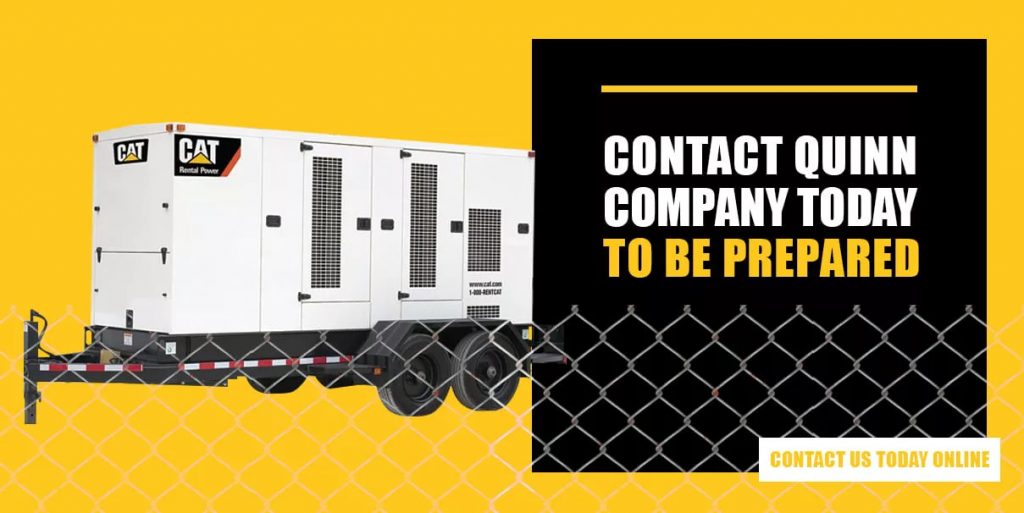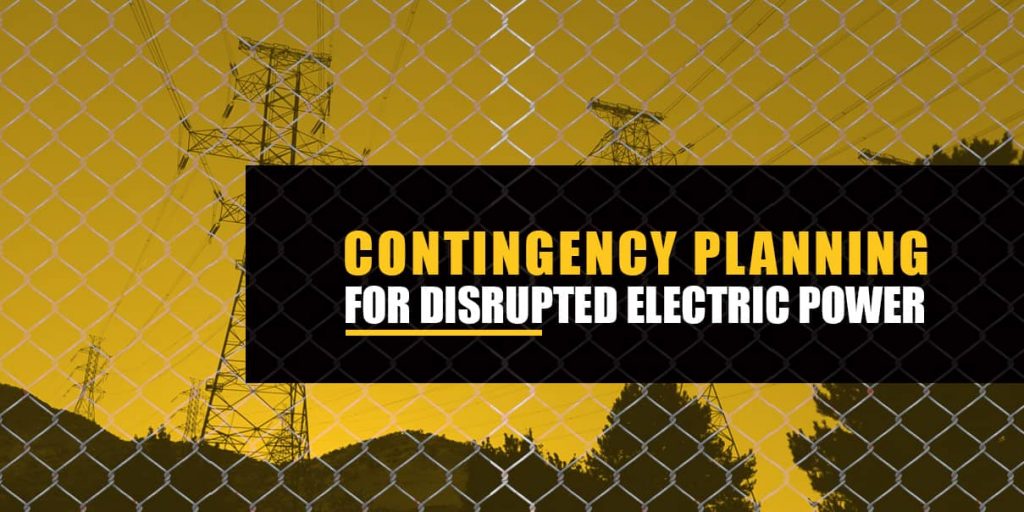
When considering the many different factors that contribute to a business’s productivity and profitability, power is often taken for granted. Whether a company relies on the public utility power grid or uses its own independent generator, the convenience and security of readily available power may make it easy to forget that your power could become disrupted. Unfortunately, power disruptions do happen frequently, and they can quickly impact a company’s bottom line if they do not have a power outage contingency plan in place to keep operations running.
In this article, we’ll talk discuss the importance of developing an electric power contingency plan and what you need to know to establish your plan before a blackout hits. We’ll also look at what emergency generator rental requirements you need to be aware of, as well as how to select the best rental company to work with. If you want your business to continue to thrive, even in the event of a power disruption, then it’s wise to take the time to inform yourself now so you can rest easy, knowing you’re well prepared.
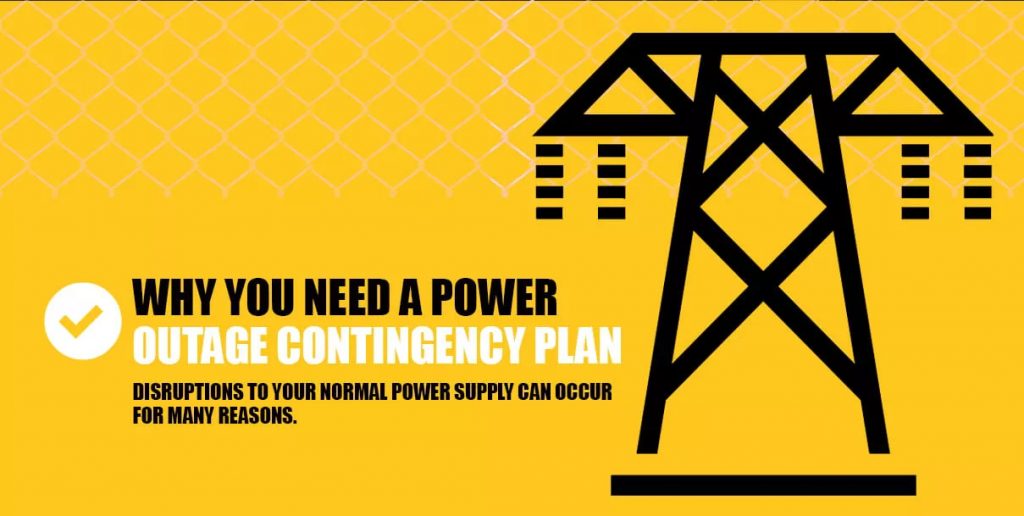
Why You Need a Power Outage Contingency Plan
Disruptions to your normal power supply can occur for many reasons. In some cases, you may have lead time to plan for an expected power disruption, but more often, power outages occur as the result of unforeseeable circumstances, including:
- Inclement weather, such as flooding, ice or heavy snowfall
- Technological malfunctions, including short circuits, blown fuses or broken machinery
- Human error, including failure to properly maintain a generator or to ensure connections to the power grid are secure and reliable
No matter the cause, unexpected power outages can lead to lost time and profits. Any number of additional issues might arise from the loss of power, including:
- Data loss
- Interrupted sales or services
- Irreparable damage to company assets, such as equipment or material
- Safety hazards and resulting liability issues
To minimize the potential damage from power disruption, implement detailed contingency plans to get the power back and operations back up as quickly as possible.
Just having a single backup method of power isn’t always enough. Even companies that have invested in backup or standby generators may find the issue that knocked out their primary generator is also affecting the backup, or the backup may be insufficient for their particular power needs during an emergency. In these cases, renting a generator for temporary use may mean the difference between losing and saving your company’s assets, including time and money.
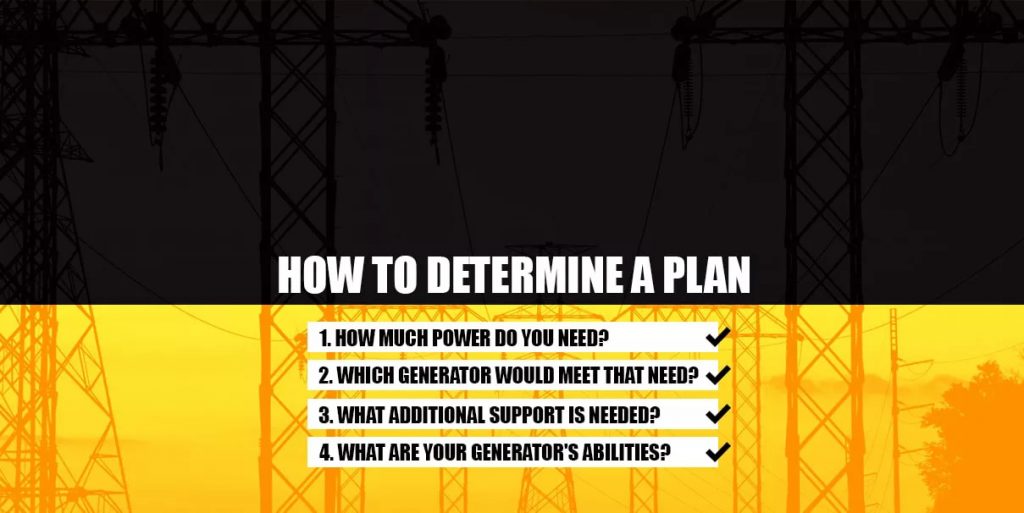
How to Determine a Plan
The ideal time for electric power contingency planning is not when the lights go out and your operations screech to a halt. Your blackout contingency plan should start by gathering important information. Your company needs to be aware of and consider many things before a power loss. Knowing these things can help you rent the best generator and return to productivity shortly after experiencing a power disruption. Here are the four main things you’ll need to determine to be ready:
1. How Much Power Do You Need?
Determine how much power your company requires to continue operations. This means deciding whether every process must be powered again immediately, or if some critical processes should be prioritized and not others. If some operations may remain down without having much of an effect on your bottom line, you may find it more cost-effective to allow those to remain idle for a time.
It’s helpful to determine what the overall cost is to your company for each process to be down and whether some processes are necessary to other processes. In other words, which processes, if down, would immediately cost you a great deal or would create a negative ripple effect? Making this determination will allow you to minimize the negative impact from a power disruption by getting power to key areas more quickly.
2. Which Generator Would Meet That Need?
When you have determined what your power needs are in the event of a disruption, you will be able to make an informed decision as to which generator would best serve your specific needs. Generators come in a wide variety of options, and the only way to make the most practical and cost-effective choice is to have a functional understanding of your power needs, first, and then of the different offerings a rental company has.
While there are many different types and models of generators to choose from, in this case, the key information to note is what amount of power the generator is capable of supplying.
3. What Additional Support Is Needed?
With your needs identified and a generator chosen, you will then need to consider what additional services or equipment you will require. Do you have a means of transporting the generator, or will it need to be delivered? Do you have someone trained to connect and maintain it, or will the rental company need to provide that service? Do you have the necessary hardware, including cables, transformers, distribution panels and more?
These may seem like insignificant details, but part of electric power contingency planning is being aware of these details, as trying to figure them out when the time comes for an emergency power rental could slow down the process. Asking yourself these sorts of questions in advance will help to streamline the process of getting power back to your operation and improve your overall experience of renting a generator.
4. What Are Your Generator’s Abilities?
Finally, consider whether the generator you’ve selected is sufficient to run additional equipment or processes beyond what you identified as critical priorities in the beginning. After making sure your vital operations are powered first, you can maximize the benefit of your rented generator by using it to its fullest capacity to power other, less important processes.
When you’re considering your generator’s full abilities, it’s important to understand that the maximum power listed for a particular generator is not necessarily the amount of power you should plan to use. Generally speaking, you shouldn’t use the maximum power output of a generator for more than a short time. Instead, consider your generator’s abilities for longer durations based on about 90 percent of the maximum power output. This percentage is referred to as the generator’s rated power.
What Options Are Available for Generators
There are several types of generators available, all with different benefits and limitations. Some run on gasoline, others run on diesel and still others require natural gas for operation. It is obviously best to discuss all of the options with a representative of the rental service, but the following brief explanations of some common types may help to guide you toward the best choice.
1. Types of Generators
Before we get into more detailed information regarding generator set ratings, let’s start by looking at four basic types of generators. These types include:
- Portable: A portable generator, as distinct from a mobile generator, is the smallest type of generator. This type is ideal for running smaller equipment and operations and is easily transported and used by you, the renter. These generators are comparable to those used by the average homeowner or during a renovation, and they run on average between 1200 and 7500 watts.
- Mobile: A mobile generator is much larger than a portable generator, and so requires a truck or similar vehicle equipped with a hitch for transport. This increase in size, though, makes the portable generator ideal for longer-term operations that require more power, but not as a permanent power source. Mobile generators offer between 20 and 2500 kVA.
- Standby: A standby generator is neither mobile nor portable but may offer the power needed immediately in the event of a power grid failure or primary generator malfunction. Standby generators vary with regard to fuel but offer on average between 20 and 2500 kVA. The benefit of the standby unit, as opposed to the mobile, is that you may have it installed in your facility and may rely on the rental company to ensure that it is properly maintained and ready when the unexpected happens.
- Primary: A primary generator is intended to be your company’s first source of power. While it may seem counter-intuitive to rent your primary power source, this option offers the same benefit of round-the-clock service by the rental company, while also guaranteeing that you can choose a primary power source that is tailored specifically to your needs at any given job. These units provide between 158 and 270 kW — more than sufficient for most companies’ needs.
Browse Our Generators for Sale
2. Generator Set Ratings
We can think of different types of generators in terms of their ratings. The International Standards Organization (ISO) publishes industry standard guidelines for generator sets in ISO-8528. Though many generator set manufacturers are using their own specifications, the ISO set rating categories are a helpful place to start. These categories include:
- Emergency Standby Power (ESP)
- Limited-Time Running Power (LTR)
- Prime Running Power (PRP)
- Continuous Operating Power (COP)
Cat generators, some of the best in the industry, are classified according to these four categories, as well as two others:
- Standby
- Mission Critical Standby
These ratings all differ in their capabilities regarding run hours, peak load and average load. Understanding generator set ratings helps you make sure you’re selecting the generator that best meets your power needs. Let’s take a closer look at the different generator set types that Caterpillar® offers:
- Emergency standby power: Because ESP is intended for temporary emergencies, it is only designed to run up to 200 hours per year at 70 percent output and with varying loads. Though ESP is different from Standby Power, note that some manufacturers conflate these two ratings.
- Standby power: The only difference between ESP and Standby Power, other than the fact that Standby Power is not included ISO-8528, is that traditional standby generators are designed to provide backup power for up to 500 hours per year, also at 70 percent capacity with varying loads.
- Mission critical standby: Another standard that has no ISO equivalent, Mission Critical Standby generators can meet the demand of some industries, such as data centers, for a higher average load factor. It can run at 85 percent output with varying loads for up to 500 hours in a year. Typical peak demand would require 100 percent of the rating for up to five percent of the total operating time.
- Prime running power: Prime generators are designed to provide power to a varying load for an unlimited number of hours per year. It can be depended upon for its full nameplate rating for limited amounts of time, but the average load factor should not exceed 70 percent. In emergencies, a 10 percent overload is allowed for up to one hour out of 12, not to exceed 25 hours per year.
- Continuous operating power: As with PRP generators, COP generators can supply power for an unlimited number of hours per year. However, they are designed for non-varying loads. On the positive side, Continuous Power generators can provide 100 percent of their nameplate rating for the entire duration of runtime.
3. Other Factors to Consider
As you select the right generator to power your operations, also consider these factors:
- Portability: Depending on size, most rental generators are skid-mounted on either a fuel tank base or mounted on a trailer or van. Make sure you know how you’re going to get your generator where you need it.
- Placement: When finding a location for your generator, remember that all generators must be placed outdoors at an adequate distance away from buildings. In addition to this consideration, think through how accessible certain areas would be to a fuel truck when it comes time for refueling.
- Sound: Generators tend to be fairly loud, so if you need your generator to be quiet to keep from disturbing neighboring areas, make sure you find a sound-attenuated generator with a rating below 92db(A) at full load.
- Connections: Determine how power cables will connect the generator to equipment or the electrical distribution boxes in a way that will maintain proper standards of safety, security and environmental concerns. Consider using spider boxes as a base for multiple plug-ins.
- Auto start/stop: If the rental generator is being used to back up a permanent standby unit, then you’ll want an auto start/stop feature included. This feature will automatically engage the generator if your permanent standby unit goes down.
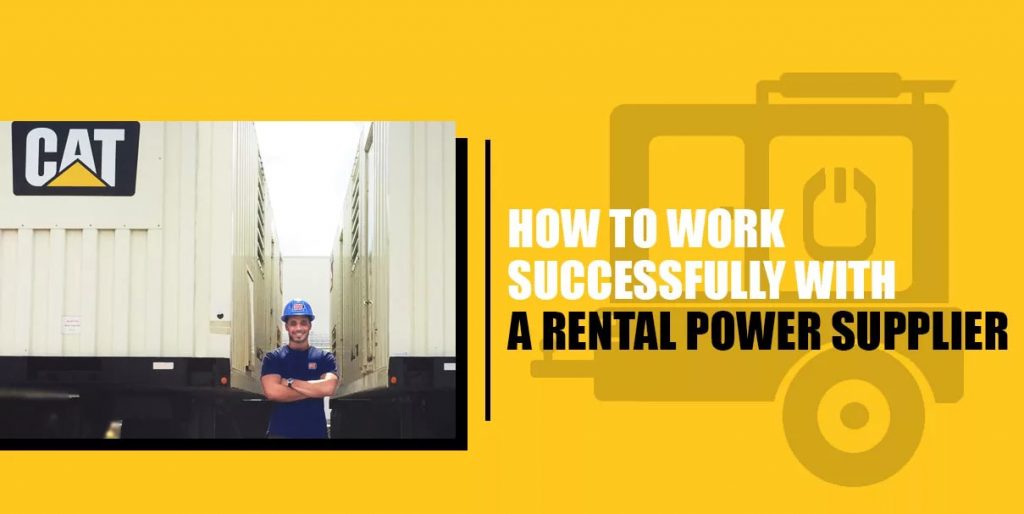
How to Work Successfully With a Rental Power Supplier
When your generator power contingency plan involves renting, you should not only be concerned with the equipment itself but also with the relationship you form with your rental company. Ideally, your rental company should be a fantastic resource beyond just providing the product you need.
Logistical Concerns
In addition to being aware of your needs, you need some information from your rental company to be fully informed and prepared. When you rent from a power supply company, be aware of these logistical concerns that will make a difference in the services you receive. Here are a few considerations to keep in mind:
- Rental provider’s capabilities: Make sure you know what selection a rental company has and how quickly they can get a product to you.
- Delivery or pickup: Check with the supply company so you know who is responsible for transporting the generator from the rental location to your location.
- Maintenance and support: Be aware of who is responsible for installing and maintaining your equipment and what kind of ongoing technical support your generator will require.
- Fueling: Find out how much fuel your generator requires and how refueling will be handled if your generator runs out of fuel.
- Security: Generators should already be designed to be secure, but you can ask your rental company for continuous remote monitoring.
- Backup to the backup: Make sure you trust the quality of your rental generator and that you know what your rental company will do if it happens to go down.
Once you do choose a power supply company and have equipment in place, do your part by keeping an eye on things and run tests to make sure equipment is functioning as it should. Also, be sure to keep a contact list on hand for a quick connection to your rental company and any related services, should the need for assistance arise.
Browse Our Generators for Rent
Choosing a Rental Power Supplier With a Wealth of Expertise
If you feel a bit overwhelmed trying to develop your contingency plan for a blackout, the good news is, you are not on your own. When you plan to rent a generator, you not only benefit from the rental equipment itself but from the expertise of your rental company, as well.
With that in mind, consider the expertise and experience of the rental companies who offer emergency generator rentals before selecting a company to rent from. They should be intimately familiar with the various applications that generators may be used for, as well as the technical knowledge necessary to understand what generator would be best in any given situation.
To choose the best rental supplier, ask yourself these questions:
- What is the scope of their network?
- Is their equipment state-of-the-art?
- How flexible are they? Will they customize to my needs?
- Do they have a reputation for excellence and expertise?
- Do they have established partnerships with quality suppliers of ancillary equipment?
- What is their customer service like? Can I contact them at any time?
Contact Quinn Company Today to Be Prepared
Throughout fifteen counties in central and southern California, Quinn Company can be counted on to deliver quality Cat power supply rentals and excellent service. Quinn has been around since 1919 and, across our 22 locations and more than 1,200 employees, continues to live up to our ongoing reputation for integrity, quality and service.
Learn more about our power systems for rent and download our helpful guide on power outage contingency planning that features a rental power checklist to help you realize your plan. If you have any questions, contact us today online, or give us a call at 888.987.8466. You can also locate a representative near you if you want to talk in-person. Quinn is here to help you be prepared, no matter what.
